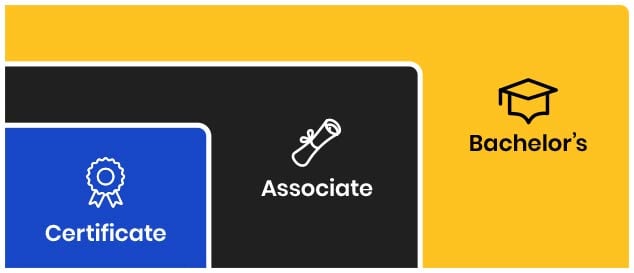Stacking degrees strategically can help you build a versatile and marketable skill set, allowing you to adapt to evolving job markets. The idea is to layer your education to maximize career opportunities while minimizing redundancy.
Contents:
- 1. Start with a Broad Foundation
- 2. Identify Your Career Path
- 3. Add a Specialized or Skills-Based Credential
- 4. Pursue a Master’s Degree with Purpose
- 5. Leverage Cross-Disciplinary Knowledge
- 6. Integrate Certifications and Industry-Specific Training
- 7. Consider an Executive or Advanced Degree
- The Best Strategy for Your Degrees
1. Start with a Broad Foundation
Begin with a general degree Associate or Bachelor’s Degree that offers flexibility. An associate degree provides foundational skills in areas like business, IT, or health sciences. It’s also more affordable and faster, allowing you to enter the workforce or transfer to a four-year program later. For example, a general Associate in Science goes a long way because you can branch out into many areas of science in your next step.
Make sure the classes you take for this degree are “university transfer” so you can use them toward a bachelor’s degree in your next step.
2. Identify Your Career Path
Once you’ve completed your first degree, try to identify your long-term career goals before you chose your bachelor’s degree. Choose a field that provides strong career options, like computer science, business administration, healthcare, or engineering.
Ask yourself:
- What fields or roles interest you?
- What are the industry demands?
- Are there skills or certifications you need for specific career growth?
A bachelor’s degree will give you broad knowledge and access to entry-level roles. Research how advanced degrees or specialized certifications align with your career path.

3. Add a Specialized or Skills-Based Credential
After a general degree, consider adding a targeted credential or certification that addresses a specific skill or area of expertise. These can be shorter programs (1-2 years) and are typically more affordable than a second full degree. Examples include:
- Post Batchelor Certificate
- Graduate Certificate in data science, project management, or cybersecurity.
- Professional Certifications like CPA (accounting), PMP (project management), or CompTIA (IT).
Specializations enhance your qualifications without requiring the time or money of a full degree. If you want to eventually pursue a master’s degree, look for programs that have certificates that stack. This way you can earn a credential on your way to competing the program.
4. Pursue a Master’s Degree with Purpose
If your field requires or benefits from advanced education, pursue a master’s degree that complements your existing skill set. This is where you focus on vertical stacking—using your master’s to deepen expertise in your original field or horizontal stacking—exploring a new but related discipline.
- For example, if you have a bachelor’s in business, pursue a Master of Business Administration (MBA) with a focus on management or marketing.
- If you have a degree in computer science, pursue a Master’s in Data Science or Artificial Intelligence.
Be selective with your master’s program and ensure it aligns with high-demand career paths.
5. Leverage Cross-Disciplinary Knowledge
Stack degrees in complementary but diverse fields to make yourself more marketable:
- Example 1: A bachelor’s in engineering and a master’s in business (MBA) make you suitable for leadership roles in tech companies.
- Example 2: A bachelor’s in biology and a master’s in public health set you up for roles in health policy, epidemiology, or healthcare administration.
- Example 3: A bachelor’s in psychology and a certificate in human resources position you well for people management and organizational development roles.
This cross-disciplinary approach allows you to switch industries or combine expertise for unique career opportunities.
6. Integrate Certifications and Industry-Specific Training
Ongoing education and certification are crucial, especially in industries like tech, finance, and healthcare. Adding industry certifications throughout your career helps you stay competitive.
- In IT, certifications like AWS Certified Solutions Architect or Microsoft Certified Azure show expertise in cloud computing.
- In business, a Lean Six Sigma Certification can enhance your problem-solving skills.
- In healthcare, adding specialized training in health informatics or nursing leadership boosts your credentials.
7. Consider an Executive or Advanced Degree
Later in your career, if you aim for leadership or top-tier positions, consider an executive MBA, PhD, or professional degree (e.g., JD for law, MD for medicine). This is often the final step for those seeking top management, research, or academic roles.
The Best Strategy for Your Degrees
- Start broad with an associate’s or bachelor’s degree.
- Identify career goals and align them with industry needs.
- Specialize with a skills-based credential, certification, or graduate certificate.
- Pursue a master’s degree strategically, either deepening your expertise or expanding into a complementary field.
- Leverage cross-disciplinary knowledge to make yourself marketable in diverse roles.
- Stay updated with certifications and training relevant to your field.
- Consider an advanced degree (optional) if leadership or highly specialized roles are your goal.
This approach maximizes your educational investment and opens up a wide range of career opportunities.
Related:
